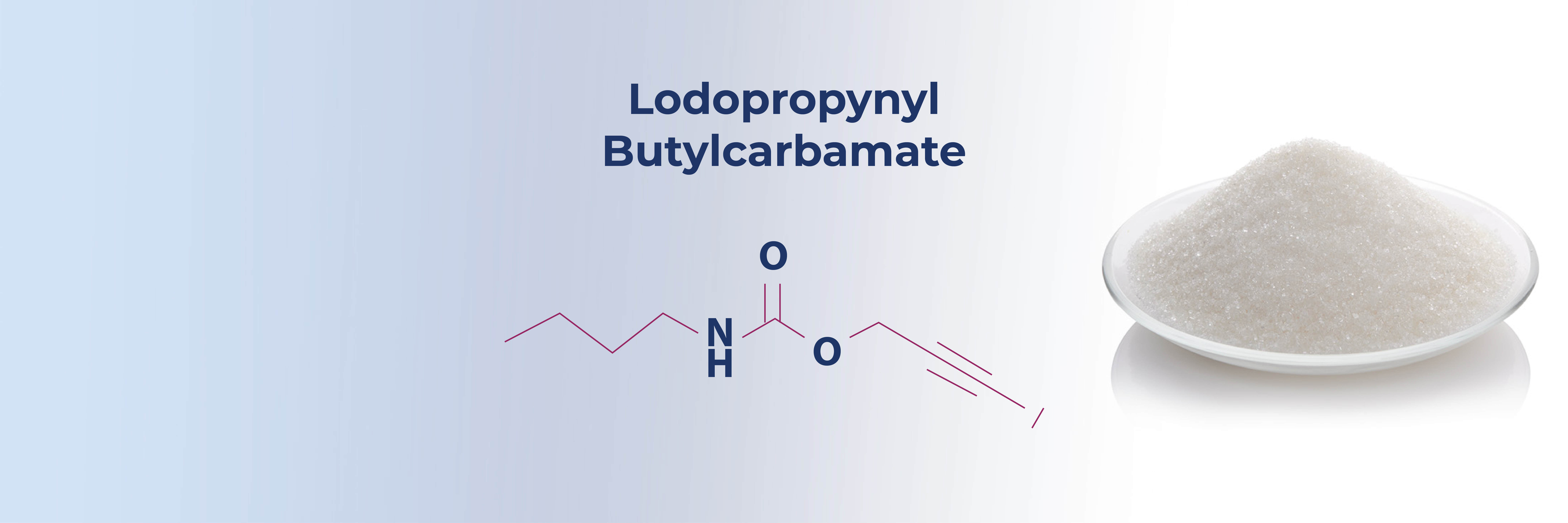INTRODUCTION
Iodopropynyl butylcarbamate, also known as IPBC, is an antimicrobial ingredient commonly used in cosmetics. It appears as a white, crystalline powder. It is not a paraben; it belongs to a different chemical class called carbamates. It is soluble in both water and oil-based systems. IPBC was invented in the 1970s and has a long history of effective use as an antifungal technology.
MANUFACTURE
IPBC is typically synthesized through a reaction between iodine, butylamine, and carbamic acid. The reaction forms the Iodopropynyl butylcarbamate compound, which is then further processed and purified to obtain the final product. .
| Synonym | 3-Iodo-2-propynyl butylcarbamate |
| CAS no. | 55406-53-6 |
| EINECS No | 259-627-5 |
| Molecular formula | C9H12IN3O2 |
| Molecular weight | 281.09 g/mol |
| Structure |  |
APPLICATIONS
Iodopropynyl Butylcarbamate is widely used in the cosmetics industry for its antimicrobial properties and preservative capabilities. It is incorporated into various cosmetic formulations to prevent the growth of bacteria, yeast, and mold, thereby extending the shelf life of the products.
| Baby Care |
|---|
| Baby lotion |
| Baby wash and shampoo |
| Diaper rash cream |
| Flushable moist wipes |
| Hair Styling Products |
|---|
| Gel |
| Hairspray |
| Pomade |
| Root lifter |
| Lotions and Skin Care Products |
|---|
| Acne treatment |
| Anti-itch cream |
| Bar soap |
| Body lotion |
| Moisturizer |
| Wrinkle cream |
It is also used as a biocide in paints, primers, and industrial coolants and cooling lubricants
SPECIFICATIONS
| Test | Unit | Specification |
|---|---|---|
| Description | – | White to off white to light yellow crystalline powder |
| Clarity (5% solution in methanol) | – | Clear solution |
| Moisture | % | NMT 0.50 |
| Melting Point | °C | 65.0 – 71.0 |
| Assay (by HPLC) | % | NLT 98.0 |
PACKING
25 kg UN approved drum.
STORAGE
Keep containers tightly closed in a dry, cool and well-ventilated place. Store at room temperature.
CERTIFICATION
ISO 9001-2015, ISO 14001-2015, ISO 22000-2018, FDA – Manufacturing License, WHO–GMP
REACH Status
Not registered yet.
No matter the quantity you need, our exceptional quality and service will make ExSyn your supplier of choice! If you need any additional information or SDS, please contact us.
5-Methyl-3-vinyl-2-oxazolidinone (V-MOX) is a highly reactive monomer valued for its low viscosity, mild odor, and excellent reactivity. It is widely used as a reactive diluent in UV-curable inks and coatings, where it enhances adhesion, produces brighter colors, and improves safety compared to conventional diluents. In addition, V-MOX serves as a key building block in the synthesis of kinetic hydrate inhibitor (KHI) polymers, which are applied in oil and gas production to prevent hydrate blockages in pipelines.
Zinc ricinoleate is the zinc salt of ricinoleic acid, a hydroxylated fatty acid derived mainly from castor oil (Ricinus communis). It appears as a white to slightly yellowish powder, waxy solid, or paste, depending on formulation. Its most valuable property is its ability to trap and absorb odor molecules such as amines, sulfides, and short-chain fatty acids, making it an essential ingredient in deodorant and odor-control products.
2-(tert-Butyl amino)ethyl methacrylate (TBAEMA) is a functional methacrylate monomer that contains a secondary amine group and a hydrophobic tert-butyl moiety, giving it excellent versatility in pH-responsive and adhesion-enhancing polymer systems.
It is valued in printing ink formulations for its ability to enhance adhesion, flexibility, and surface interaction.
Commonly known as potassium bis(fluorosulfonyl)imide (KFSI), the compound has a three-carbon backbone bearing six fluorine atoms and two sulfonimide (-SO₂F) groups. The molecule’s architecture lends it both high chemical stability and useful reactivity. Because of its excellent ionic conductivity and thermal / electrochemical stability, it finds use in advanced electrolyte formulations—for example in lithium-ion and next-generation batteries, in ionic liquids, and in other electrochemical systems.
Colchicine is a naturally occurring alkaloid obtained primarily from the autumn crocus (Colchicum autumnale) and related species. It has been used in medicine for centuries, especially for the treatment of gout and Familial Mediterranean Fever. In modern medicine, Colchicine is valued also in conditions like pericarditis, Behçet’s disease, and certain dermatological and cardiac disorders.
1-Butylimidazole is a versatile organic heterocyclic compound belonging to the imidazole family, where a butyl group (–CH₂–CH₂–CH₂–CH₃) is attached to the nitrogen atom at the 1-position of the imidazole ring. Its applications span organic synthesis, materials science, and bioactive compound development due to its tunable physicochemical properties and structural versatility.
Atropine sulfate monohydrate is a chemical compound, specifically a salt of atropine and sulfuric acid, with one water molecule (monohydrate) attached. It is commonly used as a medication and in research due to its anticholinergic properties, meaning it blocks the effects of acetylcholine at muscarinic receptors.
4-Aminobenzoic acid, commonly abbreviated as PABA, is an aromatic amine and carboxylic acid compound. It consists of a benzene ring substituted with an amino group (–NH₂) in the para position to a carboxylic acid group (–COOH).
2-Amino-5-Nitrophenol (5-NAP) is an organic compound with the molecular formula C₆H₆N₂O₃. It is a substituted phenol with both an amino group (-NH₂) and a nitro group (-NO₂) attached to a benzene ring, along with a hydroxyl group (-OH).
